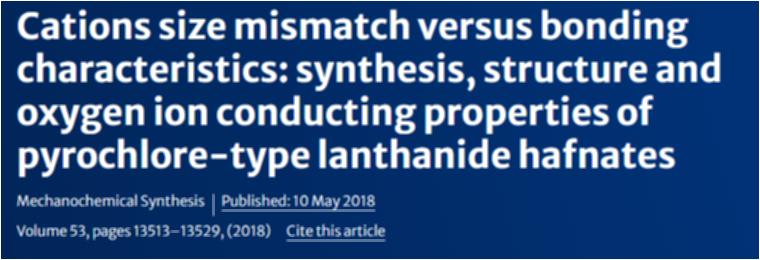Por favor, use este identificador para citar o enlazar este ítem:
http://hdl.handle.net/10637/14825Cations size mismatch versus bonding characteristics: synthesis, structure and oxygen ion conducting properties of pyrochlore-type lanthanide hafnates
| Título : | Cations size mismatch versus bonding characteristics: synthesis, structure and oxygen ion conducting properties of pyrochlore-type lanthanide hafnates |
| Autor : | Cepeda-Sanchez, Nayeli M. Diaz-Guillen, Jose A. Maczka, Miroslaw Amador Elizondo, Ulises Julio Fuentes, Antonio F. |
| Materias: | Cation Size Mismatch; Gd Hf; Gd 2Hf 2O; Pyrochlore Structure; Xb Xo |
| Editorial : | Springer |
| Citación : | Cepeda-Sanchez, Nayeli M.; Diaz-Guillen, Jose A.; Maczka, Miroslaw; Amador, Ulises; Fuentes, Antonio F. Cations size mismatch versus bonding characteristics: synthesis, structure and oxygen ion conducting properties of pyrochlore-type lanthanide hafnates. J Mater Sci 53, 13513–13529 (2018). DOI: 10.1007/s10853-018-2402-5 |
| Resumen : | This work describes the synthesis, structural characterization and electrical properties of solid solutions with the general formula Gd2Hf2−xBxO7, where B = Ti4+, Sn4+ and Zr4+. All samples were successfully prepared in ~ 30 h, via a mechanochemical reaction in a planetary ball mill, using the corresponding elemental oxides as starting chemicals. The XRD and Raman spectroscopy analysis of the title samples revealed that on firing at 1500 °C Hf4+ substitution by Sn4+ and Ti4+ produces better ordered pyrochlore structures and decreases the electrical conductivity of Gd2Hf2O7 by more than two orders of magnitude (from 2.7 × 10−4 at 700 °C to 8.71 × 10−7 and 1.12 × 10−6 Sm cm−1, for Gd2Sn2O7 and Gd2Ti2O7, respectively). By contrast, the Gd2Hf2−xZrxO7 system remains disordered with conductivity increasing by almost an order of magnitude and reaching a value for Gd2Zr2O7 of 1.55 × 10−3 Sm cm−1 at 700 °C, whereas the activation energy for oxygen migration decreases in both, the Sn- and Ti-containing systems, and increases slightly in the Zr-containing solid solution. These changes cannot be only explained when taking into account the cations size ratio criteria; the covalency of the <B–O> metal bond plays also a key role in determining the structural characteristics and electrical properties of the title three systems. |
| URI : | http://hdl.handle.net/10637/14825 |
| Derechos: | http://creativecommons.org/licenses/by-nc-nd/4.0/deed.es |
| ISSN : | 1573-4803 |
| Fecha de publicación : | 10-may-2018 |
| Centro : | Universidad San Pablo-CEU |
| Aparece en las colecciones: | Facultad de Farmacia |
Los ítems de DSpace están protegidos por copyright, con todos los derechos reservados, a menos que se indique lo contrario.


